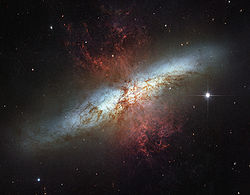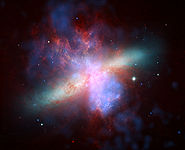- Messier 82
-
Messier 82 
Observation data (J2000 epoch) Constellation Ursa Major Right ascension 09h 55m 52.2s[1] Declination +69° 40′ 47″[1] Redshift 203 ± 4 km/s[1] Distance 11.5 ± 0.8 Mly (3.5 ± 0.3 Mpc)[2] Type I0[1] Apparent dimensions (V) 11′.2 × 4′.3[1] Apparent magnitude (V) 8.41[3][4] Notable features Edge on starburst galaxy Other designations NGC 3034, UGC 5322, Arp 337, Cigar Galaxy, PGC 28655, 3C 231[1] See also: Galaxy, List of galaxies Messier 82 (also known as NGC 3034, Cigar Galaxy or M82) is the prototype[5] nearby starburst galaxy about 12 million light-years away in the constellation Ursa Major. The starburst galaxy is five times as bright as the whole Milky Way and one hundred times as bright as our galaxy's center.[5]
In 2005, the Hubble Space Telescope revealed 197 young massive clusters in the starburst core.[5] The average mass of these clusters is around 2×105 M⊙, hence the starburst core is a very energetic and high-density environment.[5] Throughout the galaxy's center, young stars are being born 10 times faster than they are inside our entire Milky Way Galaxy.[6]
Contents
Structure
 This is a composite image made from three satellite observation projects. Visible aspects of the galaxy were taken by the HST. It is also shown in invisible infrared and X-ray spectrums: Spitzer photographed it in infrared, which shows dust emission, and Chandra photographed it in X-ray (showing mostly synchrotron emissions from fast electrons). The X-ray emission is shown in the blue parts.
This is a composite image made from three satellite observation projects. Visible aspects of the galaxy were taken by the HST. It is also shown in invisible infrared and X-ray spectrums: Spitzer photographed it in infrared, which shows dust emission, and Chandra photographed it in X-ray (showing mostly synchrotron emissions from fast electrons). The X-ray emission is shown in the blue parts.
M82 was previously believed to be an irregular galaxy. However, in 2005, two symmetric spiral arms were discovered in the near-infrared (NIR) images of M82. The arms were detected by subtracting an axisymmetric exponential disk from the NIR images. These arms emanate from the ends of the NIR bar and can be followed for the length of 3 disc scales. Even though the arms were detected in the NIR images, they are bluer than the disk. Assuming that the northern part of M82 is nearer to us, which most literature assumes, the observed sense of rotation implies trailing arms. Due to M82's high disk surface brightness, nearly edge-on orientation (~80°)[5] with respect to us, and the presence of a complex network of dusty filaments in optical images, the arms were not previously detected.[7]
Starburst region
In the core of M82, the active starburst region spans a diameter of 500 pc. In optical, there are four high surface brightness regions or clumps (designated A, C, D, and E).[5] These clumps correspond to known sources at X-ray, infrared, and radio frequencies.[5] Consequently, they are thought to be the least obscured starburst clusters from our vantage point.[5] M82's unique bipolar outflow (or 'superwind') appears to be concentrated on clumps A and C and fueled by the energy injected by supernova that occur about once every ten years.[5]
The Chandra X-ray Observatory detected fluctuating X-ray emissions from a location approximately 600 light-years away from the center of M82. Astronomers have postulated that this fluctuating emission comes from the first known intermediate-mass black hole, of roughly 200 to 5000 solar masses.[8] M82, like most galaxies, hosts a supermassive black hole at its center with a mass of approximately 3 x 107 solar masses as measured from stellar dynamics.[9]
Unknown Object
In April 2010, radio astronomers working at the Jodrell Bank Observatory of the University of Manchester reported an unknown object in M82. The object has started sending out radio waves, and the emission does not look like anything seen anywhere in the universe before.[10] There have been several theories about the nature of this unknown object, but currently no theory entirely fits the observed data.[10] It has been suggested that the object could be a "micro quasar", having very high luminosity, and being fairly stable. However, microquasars also produce large quantities of X-rays, whereas no X-rays have been seen from the mystery object.[10] The object is located at several arcseconds from the center of M82. It has an apparent superluminal motion of 4 times the speed of light relative to the galaxy center.[11]
Messier 81 triggering starburst
Forming a striking pair in small telescopes with nearby spiral M81, M82 is being physically affected by its larger neighbor. Tidal forces caused by gravity have deformed this galaxy, a process that started about 100 million years ago. This interaction has caused star formation to increase tenfold compared to "normal" galaxies.
Recently, M82 has undergone at least one tidal encounter with M81 resulting in a large amount of gas being funneled into the galaxy's core over the last 200 Myr.[5] The most recent such encounter is thought to have happened around 2–5×108 years ago and resulted in a concentrated starburst together with a corresponding marked peak in the cluster age distribution.[5] This starburst ran for up to ~50 Myr at a rate of ~10 M⊙ per year.[5] Two subsequent starbursts followed, the last (~4–6 Myr ago) of which may have formed the core clusters, both super star clusters (SSCs) and their lighter counterparts.[5]
Ignoring any difference in their respective distances from us, the centers of M81 and M82 are visually separated by about 130,000 light-years.[12] The actual separation is 300+300
−200 kly.[13][2]See also
References
- ^ a b c d e f "NASA/IPAC Extragalactic Database". Results for NGC 3034. http://nedwww.ipac.caltech.edu/. Retrieved 2006-10-27.
- ^ a b Karachentsev, I. D.; Kashibadze, O. G. (2006). "Masses of the local group and of the M81 group estimated from distortions in the local velocity field". Astrophysics 49 (1): 3–18. Bibcode 2006Ap.....49....3K. doi:10.1007/s10511-006-0002-6.
- ^ "SIMBAD-M82". SIMBAD Astronomical Database. http://simbad.u-strasbg.fr/simbad/sim-id?Ident=M82. Retrieved 2009-11-29.
- ^ Armando, Gil de Paz; Boissier; Madore; Seibert; Boselli; et al. (2007). "The GALEX Ultraviolet Atlas of Nearby Galaxies". Astrophysical Journal Supplement 173 (2): 185–255. arXiv:astro-ph/0606440. Bibcode 2007ApJS..173..185G. doi:10.1086/516636.
- ^ a b c d e f g h i j k l m Barker, S.; de Grijs, R.; Cerviño, M. (2008). "Star cluster versus field star formation in the nucleus of the prototype starburst galaxy M 82". Astronomy and Astrophysics 484 (3): 711–720. Bibcode 2008A&A...484..711B. doi:10.1051/0004-6361:200809653.
- ^ Happy Sweet Sixteen, Hubble Telescope! Newswise, Retrieved on July 30, 2008.
- ^ Mayya, Y. D.; Carrasco, L.; Luna, A. (2005). "The Discovery of Spiral Arms in the Starburst Galaxy M82". Astrophysical Journal 628 (1): L33–L36. arXiv:astro-ph/0506275. Bibcode 2005ApJ...628L..33M. doi:10.1086/432644.
- ^ Patruno, A.; Portegies Zwart, S.; Dewi, J.; Hopman, C. (2006). "The ultraluminous X-ray source in M82: an intermediate-mass black hole with a giant companion". Monthly Notices of the Royal Astronomical Society: Letters 370 (1): L6–L9. arXiv:astro-ph/0602230. Bibcode 2006MNRAS.370L...6P. doi:10.1111/j.1745-3933.2006.00176.x.
- ^ Gaffney, N. I., Lester, D. F., and Telesco, C. M. (1993). "The stellar velocity dispersion in the nucleus of M82". Astrophysical Journal Letters 407: L57–L60. Bibcode 1993ApJ...407L..57G. doi:10.1086/186805.
- ^ a b c http://www.newscientist.com/article/dn18775-mysterious-radio-waves-emitted-from-nearby-galaxy.html
- ^ http://www.jb.man.ac.uk/news/2010/M82mystery/
- ^ Declination separation of 36′.87 and Right Ascension separation of 9′.5 gives via Pythagorean theorem a visual separation of 38′.07; Average distance of 11.65 Mly × sin(38′.07) = 130,000 ly visual separation.
- ^ Separation = sqrt(DM812 + DM822 - 2 DM81 DM82 Cos(38′.07)) assuming the error direction is about the same for both objects.
External links
- M82, SEDS Messier pages
- M82 at Chandra
- SST: Galaxy on Fire!
- M82 at NASA/IPAC EXTRAGALACTIC DATABASE
- ESA/Hubble images of M82
- Messier 82 on WikiSky: DSS2, SDSS, GALEX, IRAS, Hydrogen α, X-Ray, Astrophoto, Sky Map, Articles and images
- M82 The Cigar Galaxy
- M82 images with 2 semiprofessional amateur-telescopes as a result of collaboration between 2 observatories!
Messier objects List M1 · M2 · M3 · M4 · M5 · M6 · M7 · M8 · M9 · M10 · M11 · M12 · M13 · M14 · M15 · M16 · M17 · M18 · M19 · M20 · M21 · M22 · M23 · M24 · M25 · M26 · M27 · M28 · M29 · M30 · M31 · M32 · M33 · M34 · M35 · M36 · M37 · M38 · M39 · M40 · M41 · M42 · M43 · M44 · M45 · M46 · M47 · M48 · M49 · M50 · M51 · M52 · M53 · M54 · M55 · M56 · M57 · M58 · M59 · M60 · M61 · M62 · M63 · M64 · M65 · M66 · M67 · M68 · M69 · M70 · M71 · M72 · M73 · M74 · M75 · M76 · M77 · M78 · M79 · M80 · M81 · M82 · M83 · M84 · M85 · M86 · M87 · M88 · M89 · M90 · M91 · M92 · M93 · M94 · M95 · M96 · M97 · M98 · M99 · M100 · M101 · M102 · M103 · M104 · M105 · M106 · M107 · M108 · M109 · M110See also  Book:Messier objects ·
Book:Messier objects ·  Category:Messier objects
Category:Messier objects  Portal:AstronomyCategories:
Portal:AstronomyCategories:- Starburst galaxies
- Irregular galaxies
- M81 Group
- Ursa Major constellation
- Messier objects
- NGC objects
- UGC objects
- PGC objects
- Arp objects
- 3C objects
Wikimedia Foundation. 2010.

